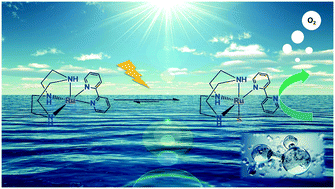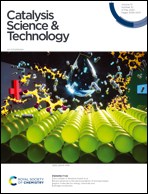Ligand photodissociation in Ru(ii)–1,4,7-triazacyclononane complexes enhances water oxidation and enables electrochemical generation of surface active species†
Abstract
Although some ligand transformations involved in metal complexes have been reported during water oxidation (WO) ((photo)chemical/electrochemical), such as ligand decomposition, partial oxidation, or complete dissociation, ligand photodissociation has not been reported yet. Here, we report the first example of ligand photodissociation in [Ru([9]-aneN3)(bpy)(DMSO)]2+, 1 (bpy is 2,2′-bipyridine), under the frequently used conditions for screening water oxidation catalysts, and its relation to the catalyst activity. We demonstrate that the observed photodissociation in complex 1 boosts its catalytic performance towards electrochemical WO and enables surface generation of electrochemically active species. Conversely, the absence of such a phenomenon in [Ru([9]-aneN3)(pic)(DMSO)]+, 2 (pic is 2-picolinate), resulted in an unreactive catalyst towards WO. DFT calculations could explain the observed difference between complexes 1 and 2 aqueous solutions towards ligand partial-dissociation when exposed to light based on the activation barrier between triplet metal-to-ligand charge transfer (3MLCT) and dissociative metal-centered (3MC) excited states as well as the stability of the 3MC state. Whereas the 3MLCT–3MC transition for complex 2 requires higher activation energy than that for complex 1, the resulting 3MC state is less stable than its 3MLCT state. Calculations involving the ligand exchange process reveal that a water molecule can replace one of the pyridine rings with a considerably lower activation barrier in the triplet state as compared to the singlet state.



 Please wait while we load your content...
Please wait while we load your content...